Customer lifetime value is a metric or index that quantifies the amount of money a customer is expected to spend while doing business with an organization and has become very useful for defining success.
In this article, I’ll discuss CLV and what it means for me at Microsoft, how you can calculate CLV and use your results to boost revenue, and most importantly, the significance of outcomes and outcome success in driving CLV.
My name is Ayman Husain, I live in Houston, in the great state of Texas, in the United States of America.
My employer is Microsoft; I joined Microsoft in 2017 and have been with them since.
My role at Microsoft is concerned with customer success. I work for the intelligent cloud division, which encompasses mostly Azure, Microsoft 365, and Dynamics 365. These are cloud platforms.
The success I have at Microsoft is to grow Azure, the use of it and the adoption of it. My success is based on how much Azure is being used by my customers. Microsoft's success is measured by the growth of the Azure platform, and also the customer lifetime value.
That is something I'll be talking about in this article, and I hope you take away some of the ideas and points of view I have regarding customer lifetime value.
My background is strategy and management consulting and some of these have come to me over years of consulting and strategizing with many customers both in IT and in business.
The agenda
What am I going to be talking about today? Driving customer lifetime value by focusing on outcome and success. Let's break it down.
- The customer is the buyer of this product's services, that's the C of the CLV.
- Lifetime is the duration of time when there'll be doing the buying, and
- Value is a measure of the worth.
Customer lifetime value has to encompass a way for us to measure the customer, duration of time, and the value that comes to us from.
I'll be writing on this topic and hope you gather some ideas that will help you understand my point of view and we can share this in a way to have greater customer success.
What is CLV?
Let's put a definition around this. What is it really? We throw around the word CLV but we have to understand the context behind it.
Every marketer, seller, or advertiser will have a unique definition for it.
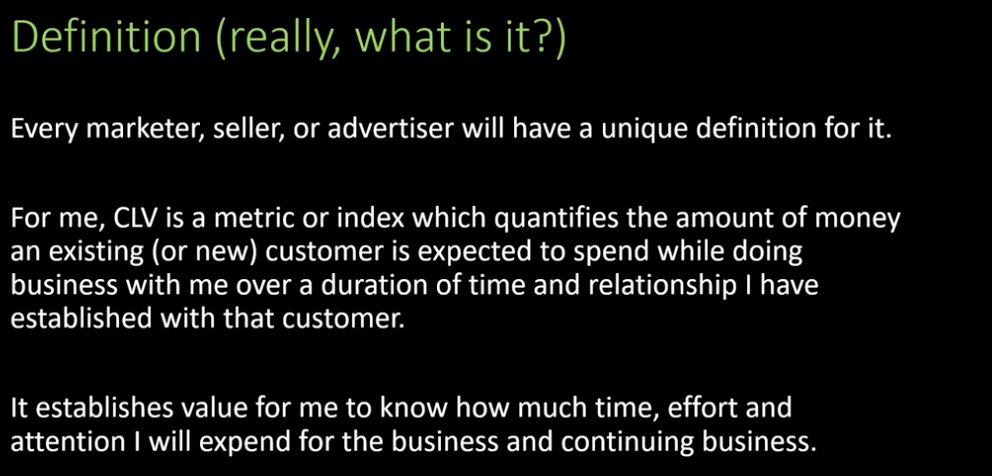
I've taken that definition, I've read about it, and I've brought it to myself, for my job, just for my personal understanding.
For me, CLV is a metric or an index that quantifies the amount of money an existing or perhaps a new customer is expected to spend while doing business with me over a duration of time.
Maybe I have a relationship during that time with them and I have established that with the customer to measure that. It establishes a value for me to know how much effort and attention I'll need to spend with them to grow the business or perhaps continue the business.
Why is it important?
CLV has become very useful for defining success in many organizations, either if you’re in the commercial space or non-commercial space. Why is it important?
It enables me to determine if I'm doing the right things, if my approach is effective, and why. Driving the boat, so to speak, to the end goal that I have for my personal success and perhaps of the customers.
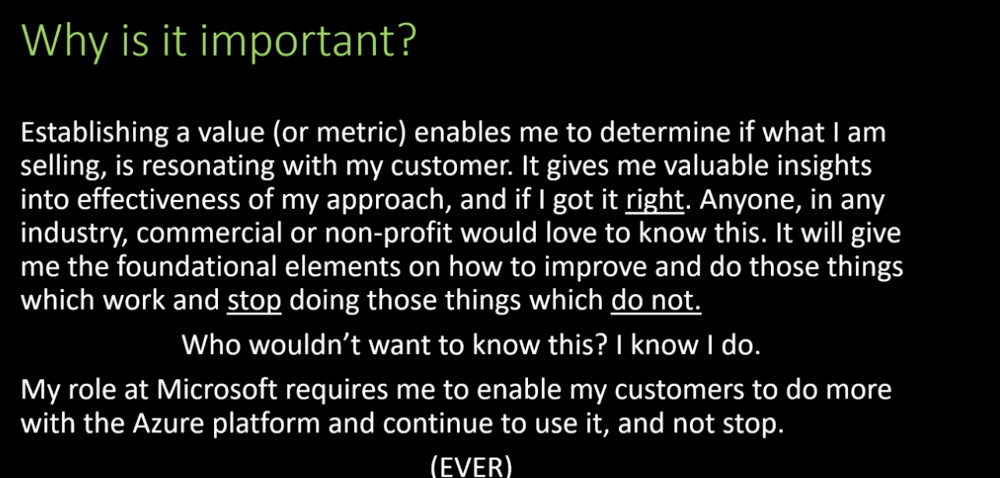
It'll give me a gauge to stop doing some things or perhaps it'll tell me to do something more. If I have this information, it makes me more effective, useful, and successful.
Why wouldn't I want this information? Who wouldn't want this information?
In my role at Microsoft, I need to make my customers do more with the Azure platform. The Azure platform is a cloud platform and I want them to continue using it. As I stated in the beginning, that is my measure of success.
So I want them to continue using it and never stop, ever. Because that is how I'm getting the most customer lifetime value.
Can you really calculate CLV?
Now is there really a way to calculate CLV? As a matter of fact, there is. This is the interesting part where we have broad math, arithmetic, and science to create a formula.
There is a very good way to do that. However, I'll also be honest, in the platform I work, in the company I work it is pretty tricky to measure complex things that are technically massive. In the cloud platform, it is very challenging.
But for simplicity, let's use an example that gives us an idea of what this formula would look like.
Example: Coffee shop
Let us pretend I'm a coffee shop owner, a proprietor of such and my coffee shop is located in a building. There's a regular stream of beverage buyers that come and go. That is my business.

Let's see how I would create a formula for calculating CLV on it. The formula goes as the average value of the purchase, the number of times the purchase is made, and the average length of the relationship.
For this example, I'm using the length of the relationship as one month. Let's take a regular cup of coffee, black coffee, nothing special about it. Let's assume it is $4 in this example.
A buyer comes into the coffee shop, because it's in an office complex, and buys one cup a day. I'm expecting this customer to buy one cup a day at $4. They work four weeks in the month, the average duration for the month, and that gives me $80 of revenue because of this customer.
Now let’s imagine a specialty beverage buyer, maybe this customer likes lattes, the latte is $8 a cup, but they don't buy enough of it. They buy three times a week, but they still come in four weeks of the month into the shop. If I calculate the CLV on that, that's $96.
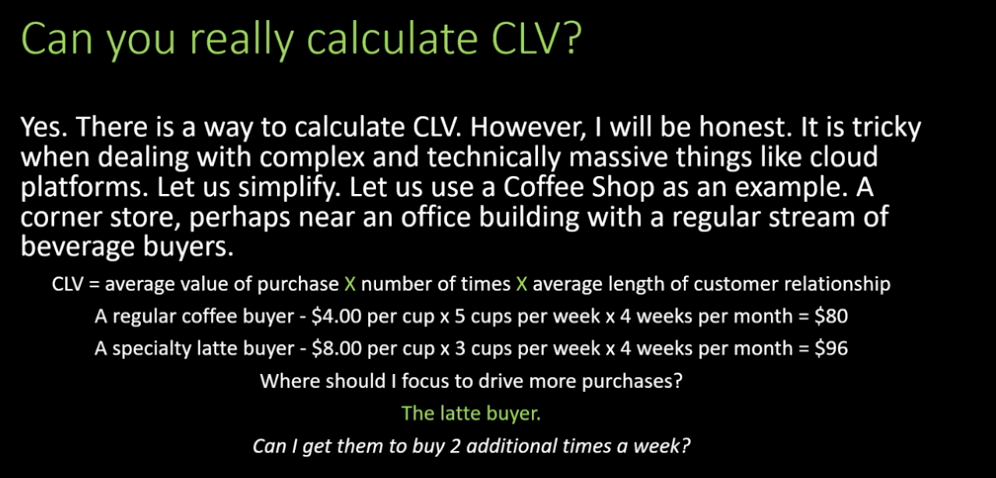
Now, as a coffee shop owner, I would sit back and say what should I do more of and what should I try to get to increase in the revenue circle?
In this example, I should focus on a latte buyer, I need to find out ways to make sure that latte buyer increases the amount of purchase from three cups a week to perhaps five. I need to be creative.
How to do this?
The CLV now gives me the ability to understand where I focus and how I will do this. While this metric is very simplified, there are many ways to get data. We live in a world of data.
We have cash registers that are collecting lots of data, we have other demographic data that can be applied, the zip code, the postal code, the location, the type of coffee, the brand, many different things that can be brought into an equation to help you establish CLV.
Let's use the coffee shop example again.
Loyalty program
Let's say I want to increase that latte buyer to buy more, maybe I create a loyalty program. The loyalty program may guarantee me some repeat business.
Customized customer profile
Maybe I create a customer profile, I want to know more about what they do, when they do it, and how they do it. I'll create a profile. That's basic CRM in many organizations, we're collecting customer data to create a profile.
Almost all retail organizations do this very well and very effectively for target marketing.
Correct mistakes immediately
Maybe I correct mistakes immediately, somebody says this latte is done wrong, I fix it right away. There's an appreciation of success based on the fact I'm responsive, I'm acknowledging fault and having that vulnerability there.
Call them by their name
Maybe I call them by name. If you’ve visited many coffee shops, especially the ones that are well known in brand, they will write your name on the cup, and they'll call you by your name.
If you're a repeat visitor, they will actually get to know you, they'll know your pattern, they'll know your style and they'll holler at you across the way as you walk in. That's the way to value the customer and make them feel special.
Upsell and add-on program
Maybe they create an upsell program, an add-on. Maybe if you buy a latte you get half off on a donut. We're creating programs to make this buyer who only buys three cups a week to five cups and there are many ways we can do that.
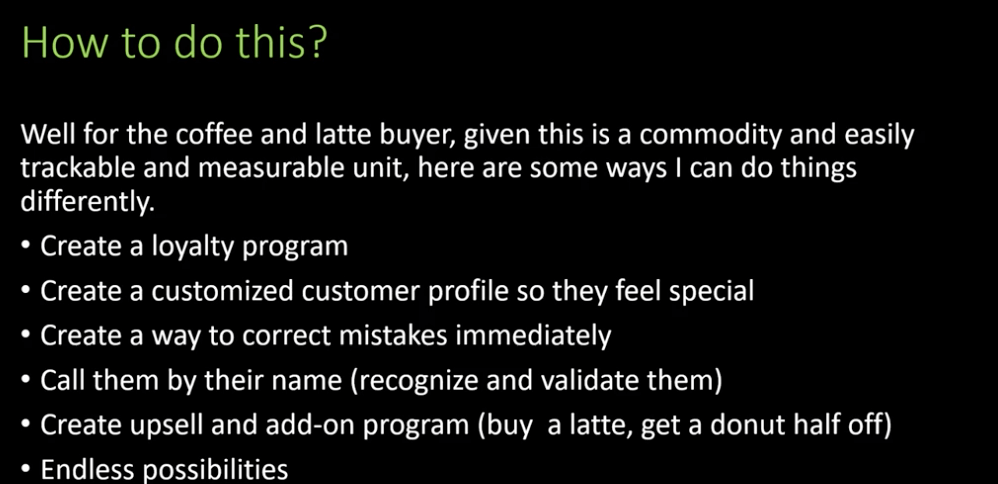
The possibilities are endless. That's a great way to think of CLV.
How would I do it?
How do I do this in my job? I work in the technology arena, I work in cloud and platform services. Not as simple as buying a cup of coffee. I have to do something here in the software as a service, platform as a service, infrastructure as a service, I have to build a CLV method that works for me.
In your organization, in your discipline, in your industry, your job, you may have to do many different things to create the CLV that works for you.
Outcomes
What I do for my job is follow outcomes. You may ask what do you mean by outcomes? I actually focus on my customers’ outcomes, their success criteria, you'll be surprised almost every customer of yours, every customer of mine has a customer of theirs.
Whether they’re in the commercial space or nonprofit they have somebody they're serving as well. I want to focus on that customer’s outcome. It could be the buyer, it could be the decision-maker, it could be the sponsor, they all have an outcome.
Let's play through it. A lot of business has an outcome:
- Maybe the CIO of an organization has an outcome for their success. It could be something very simple. The CIO may say things like, "Hey, I want to get a promotion, I don't want to get fired, I want to grow the IT portfolio", whatever it may be.
- The CMO may want more metrics and data,
- The Chief Financial Officer may want to run a very disciplined accounting organization within their ranks.
There are many ways to understand the success criteria of that sponsored business decision-making buyer, the customer you really are focusing on.
- The IT manager even has an outcome, they may want successful rollout of projects or technology.
- A salesperson may have an outcome, they want to have better leads and better success in closing deals.
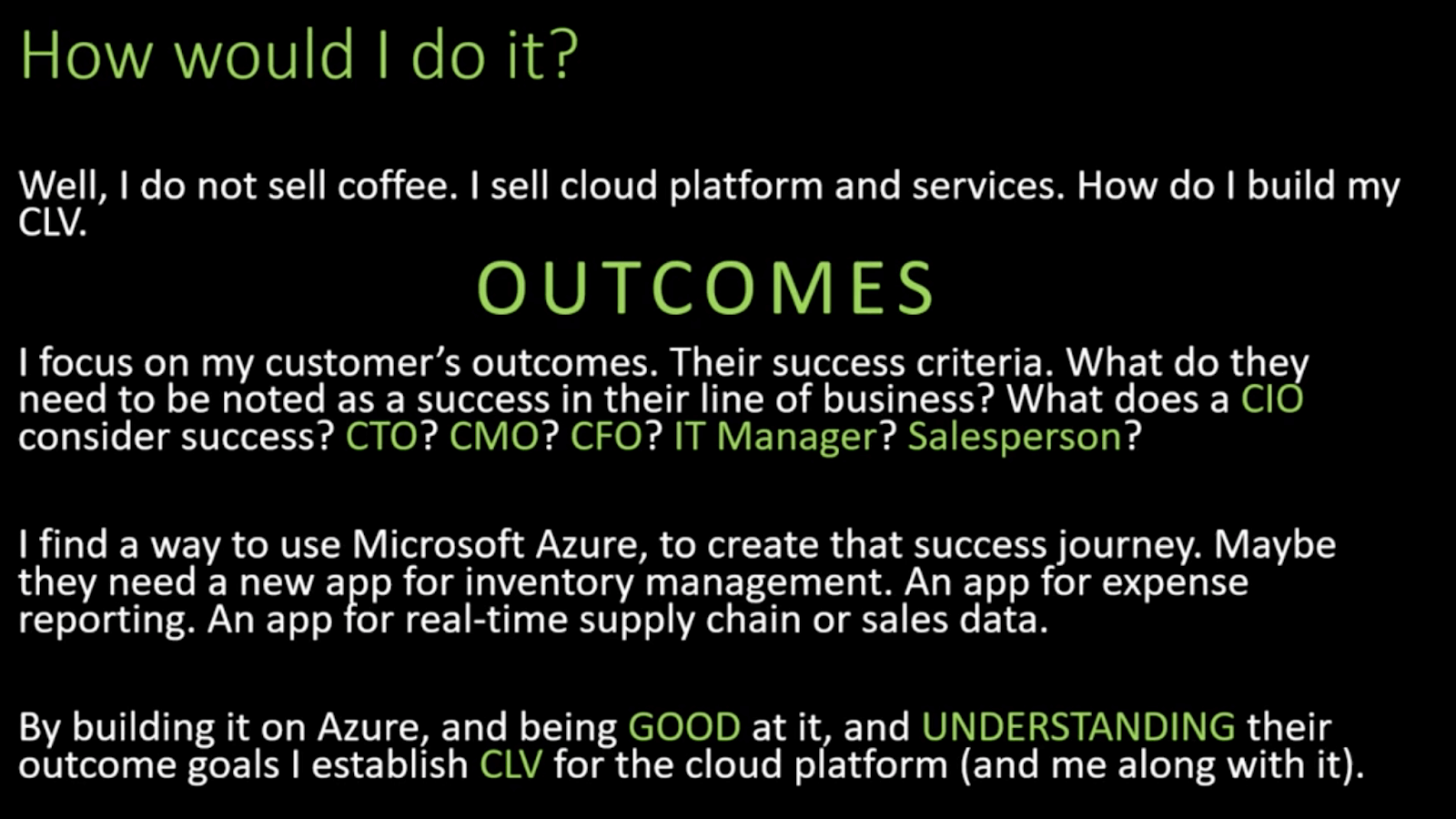
Hone in on the outcome
I focus on the outcome and you'll be surprised in any organization wherever it is, you can hone in on the outcome if you did the due diligence of the account.
If you’re in an organization where you have an account book of business, doing your homework. In the US if I were to go to a publicly traded organization, I would look at the financial documents that are available, the 10-K reports, etc.
I would create a portfolio where I could understand what kind of outcomes they would be looking at. For example, a medical center, a health care facility may have an outcome of saving lives or improving healthcare, or creating a medicine that cures diseases.
If you're in oil and gas energy markets, you may have an outcome of producing more energy at a cheaper cost. You can always understand the outcome.
Find a way to create that success journey
How does it relate to my Microsoft Azure platform job? When I've identified this outcome, I've tried to focus on how I make it successful using the technology and I'm going to solve everything.

Microsoft Azure is a cloud platform that has a peculiar way of doing certain things, you build for mobile, you build for the cloud, you have the ability to consume technology at a very transactional level, compute network, and storage.
Maybe the CFO says, "I need an app". Now I can focus on building the app in the cloud using architects and designers that would do that. But with the outcome in mind, not the Azure skew, not the product I'm selling as Microsoft but on their outcome.
Get granular
Maybe they need a supply chain app that gives them real-time data and analytics. Think of what happened during the pandemic, people ran out of toilet paper, manufacturers overseas could not supply it fast enough. Some of them shut down because of quarantine.
If you think of that, what if I had data and many of these organizations have data, what if I created a dashboard, or a data lake, or a data warehouse, where I did real-time analytics and gave them the heads up that there is going to be a shortage or there's going to be a sudden increase in demand just based on a couple of days of information.
We can get that granular if I know that's the outcome that decision-maker wants.
Establish CLV
That's how we get better at the CLV by focusing on the outcome.
Think of during the pandemic now that we have a potential cure through the vaccine, logistics and shipping companies are trying to get very good at making sure they can predict when stocks will be available at medical facilities. Think of all the technology components that can go on there.
If I was repositioning Azure, I can do a lot of great technology development from apps, data, lakes, data warehouses, analytics, IoT devices, you name it, artificial intelligence, machine learning, I could take all that and create an amazing app.

Therefore, the customer recognizes I've succeeded in creating the outcome they wanted. By virtue of that, there'll be a good amount of CLV and a good understanding will help me achieve success.
They will like what I did, they'll like what my team did, and therefore they will continue to come back to me because I can solve that problem for them. That is the way I would do it in a very complex organization like cloud. But that CLV still applies.
So how do I do success in my job? I focus on the customer lifetime value, basing it on their outcomes.
That outcome success guarantees me the customer lifetime value.
CLV: A story
I'm going to wrap up with a story. This story is not related to technology, but it is relevant to the context that we have in this article.
Context: Boston
I used to live before Houston in the Boston area of the United States of America, it's in the northeast quarter. It is cold, it's snowing in the wintertime there and homes are built to have the ability to withstand those harsh climates and weather.

I bought a house that was a little bit older and the roof was aged out. To get good insurance for the house and to make sure I don't have damage during hurricanes or nor'easter storms, I need a good roof that can stand the harsh nature of the weather.
The problem? The roof
I shopped around, I got a nice manufacturer of shingles that went on the roof, from the contractors that could come and do the job for me and we started on the project. The contractors came in, took all the old shingles off, cleaned it up, put some boards and put some laminate paper and things that would make the roof more sturdy and viable for harsh weather.
This was a three-day project, on day two, a white van pulled up in my driveway, and a gentleman stepped out with a hardhat. On the van, he had this ladder on top. I'm thinking it's a part of the crew. But it wasn't because the crew did not react to this man, as "Hey, it's part of the crew, somebody showed up".

What happened? Panic
I started worrying myself, I got a little concerned, I was like, why is this person in my driveway pulling up and taking down the ladder, and looks like he's going to climb towards the roof? Now I started thinking different things.
One of the things I started thinking was maybe I didn't draw enough permits from the city and I violated an ordinance or some zoning rule, and I'm going to get penalized with a fine. Those are the things going through my head. I'm like, that happens, maybe the contractors doing the work didn't have the right permit or didn't register with some agency that they were going to do some work like that.
Shingles have a lot of pollutants that are gonna contaminate the environment so maybe there's a disposal permit I missed or something.

It turns out, the gentleman goes up to the roof, he has an iPad, he takes pictures, and he does a lot of measurements and studies and looks at things and then comes down the ladder and he's got a broad smile on his face.
I'm looking at this smile thinking maybe he is going to fine me, maybe he is part of the city and the ordinance guy, and I'm screwed. But it turned out this person came from the manufacturer of the shingles.
The reality
When I placed the order for the shingles through the contractor through the reseller, the manufacturer got awareness I was going to have a job where I'm going to put some new roofing on my house. The manufacturer dispatched an expert, and the expert came over for a purpose, the expert wanted to make sure the shingles were being installed properly.
Why? Because this roof came with a 30-year lifetime guarantee. But if I wanted 40 years, which was possible at that time, they had to verify the installation was done right, done properly, and done within the specifics that was established by the manufacturer.
The manufacturer dispatched this person and they had to come on day two because that's when the installers were gonna start installing. They look at all the things they needed to look at. When he was satisfied, he gave me the certificate.

The certificate allowed me to get a lesser insurance premium for my house, to get it warrantied and protected for disasters. This certificate was transferable so when I sold my house, the buyer was excited that I had a 40-year warranty on the roof.
The lesson: addressing outcomes leads to CLV
Think of that, this roofing manufacturing company has a customer lifetime value that spans 30 to 40 years, they're banking on the fact if they do it right, address all the outcomes that are necessary, there will be repeat business or there'll be business through the fact the house will be sold and the resale value will always hold.
The insurance adjusters will always like that the roof was done right. And when the hurricanes and storms and snow comes through, there'll be no damage or it will be very light if any.

Think of that context, this person from the manufacturer came over to guarantee the installation so the customer lifetime value and experience went up.
The takeaway
That's the way you want to start thinking about customer lifetime value. That is the way you want to focus on outcomes and success of the person that has something to gain and it's not necessarily you selling the product. It's not necessarily you getting the business.
That outcome itself will drive the customer lifetime value. By virtue of that, you will have great insights to drive more business or more wallet share.
Thank you.

